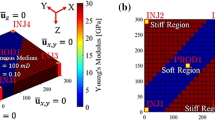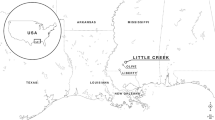Abstract
Flow diagnostics refers to a family of numerical methods that within a few seconds can compute visually intuitive quantities illuminating flow patterns and well connections for full 3D reservoir models. The starting point is a flow field, extracted from a previous multiphase simulation or computed by solving a simplified pressure equation with fixed mobilities. Time-of-flight (TOF) and stationary tracer equations are then solved to determine approximate time lines and influence regions. From these, one can derive sweep or drainage regions, injector–producer regions, and well allocation factors, as well as dynamic heterogeneity measures that characterize sweep and displacement efficiency and correlate (surprisingly) well with oil recovery from waterflooding processes. This work extends flow diagnostics to polymer flooding. Our aim is to develop inexpensive flow proxies that can be used to optimize well placement, drilling sequence, and injection strategies. In particular, we seek proxies that can distinguish the effects of improved microscopic and macroscopic displacement. To account for the macroscopic effect of polymer injection, representative flow fields are computed by solving the reservoir equations with linearized flux functions. Although this linearization has a pronounced smearing effect on water and polymer fronts, we show that the heterogeneity of the total flux field is adequately represented. Subsequently, transform the flow equations to streamline coordinates, map saturations from physical coordinates to time-of-flight, and (re)solve a representative 1D flow problem for each well-pair region. A recovery proxy is then obtained by accumulating each 1D solution weighted by a distribution function that measures the variation in residence times for all flow paths inside each well-pair region. We apply our new approach to 2D and 3D reservoir simulation models, and observe close agreements between the suggested approximations and results obtained from full multiphase simulations. Furthermore, we demonstrate how two different versions of the proxy can be utilized to differentiate between macroscopic and microscopic sweep improvements resulting from polymer injection. For the examples considered, we demonstrate that macroscopic sweep improvements alone correlate better with measures for heterogeneity than the combined improvements.
Similar content being viewed by others
References
Ates, H., Bahar, A., El-Abd, S., Charfeddine, M., Kelkar, M., Datta-Gupta, A.: Ranking and upscaling of geostatistical reservoir models using streamline simulation: a field case study. SPE Res. Eval. Eng. 8(1), 22–32 (2005). doi:10.2118/81497-PA
Bao, K., Lie, K.A., Møyner, O., Liu, M.: Fully-implicit simulation of polymer flooding with MRST. Comp. Geosci. doi:10.1007/s10596-017-9624-5 (2017)
Batycky, R.P., Thieles, M.R., Baker, R.O., Chugh, S.H.: Revisiting reservoir flood-surveillance methods using streamlines. SPE Res. Eval. Eng. 11(2), 387–394 (2008). doi:10.2118/95402-PA
Cardoso, M., Durlofsky, L.: Linearized reduced-order models for subsurface flow simulation. J. Comput. Phys. 229(3), 681–700 (2010). doi:10.1016/j.jcp.2009.10.004
Cardoso, M.A., Durlofsky, L.J.: Use of reduced-order modeling procedures for production optimization. SPE J. 15(2), 426–435 (2010)
Christie, M.A., Blunt, M.J., et al.: Tenth SPE comparative solution project: a comparison of upscaling techniques. In: SPE Reservoir Simulation Symposium. Society of Petroleum Engineers. doi:10.2118/66599-MS (2001)
Clifford, P.J., Sorbie, K.S.: The effects of chemical degradation on polymer flooding. In: SPE Oilfield and Geothermal Chemistry Symposium. Society of Petroleum Engineers. doi:10.2118/13586-MS (1985)
Datta-Gupta, A., King, M.J.: Streamline simulation: theory and practice, SPE Textbook Series, vol. 11. Society of Petroleum Engineers (2007)
Guo, Z., Reynolds, A.C., Zhao, H.: A physics-based data-driven model for history-matching, prediction and characterization of waterflooding performance. In: SPE Reservoir Simulation Conference. Society of Petroleum Engineers. doi:10.2118/182660-MS (2017)
Huseby, O., Sagen, J., Dugstad, Ø.: Single well chemical tracer tests—fast and accurate simulations. In: SPE EOR Conference at Oil and Gas West Asia, Muscat, Oman. doi:10.2118/155608-MS, pp 16–18 (2012)
Idrobo, E.A., Choudhary, M.K., Datta-Gupta, A.: Swept volume calculations and ranking of geostatistical reservoir models using streamline simulation. In: SPE/AAPG Western Regional Meeting. Long Beach, California, USA. SPE 62557 (2000)
IO Center, NTNU: The Norne benchmark case. http://www.ipt.ntnu.no/~norne/wiki/doku.php (2012)
Izgec, O., Sayarpour, M., Shook, G.M.: Maximizing volumetric sweep efficiency in waterfloods with hydrocarbon F- ϕ curves. J. Petrol. Sci. Eng. 78 (1), 54–64 (2011). doi:10.1016/j.petrol.2011.05.003
Kippe, V., Hægland, H., Lie, K.A.: A method to improve the mass-balance in streamline methods. In: SPE Reservoir Simulation Symposium. SPE 106250, Houston, Texas, USA. doi:10.2118/106250-MS (2007)
Klausen, R.A., Rasmussen, A.F., Stephansen, A.: Velocity interpolation and streamline tracing on irregular geometries. Comput. Geosci. 16, 261–276 (2012). doi:10.1007/s10596-011-9256-0
Klemetsdal, Ø., Møyner, O., Raynaud, X., Lie, K.A.: Non-linear Newton solver for a polymer two-phase system using interface-localized trust regions. In: IOR 2017 – 19th European Symposium on Improved Oil Recovery. doi:10.3997/2214-4609.201700356, pp 24–27. EAGE, Stavanger, Norway (2017)
Lake, L.W.: Enhanced oil recovery. Prentice-Hall (1989)
Leube, P.C., Nowak, W., Schneider, G.: Temporal moments revisited: why there is no better way for physically based model reduction in time. Water Resour. Res. 48(11) (2012). doi:10.1029/2012WR011973.W11527
Lie, K.A.: An Introduction to reservoir simulation using MATLAB: User guide for the Matlab Reservoir Simulation Toolbox (MRST). SINTEF ICT, www.sintef.no/Projectweb/MRST/publications (2016)
Mead, L.R., Papanicolaou, N.: Maximum entropy in the problem of moments. J. Math. Phys. 25(8), 2404–2417 (1984). doi:10.1063/1.526446
Møyner, O.: Nonlinear solver for three-phase transport problems based on approximate trust regions. In: ECMOR XV – 15th European Conference on the Mathematics of Oil Recovery. EAGE, Amsterdam, The Netherlands (2016)
Møyner, O., Krogstad, S., Lie, K.A.: The application of flow diagnostics for reservoir management. SPE J. 20(2), 306–323 (2014). doi:10.2118/171557-PA
MRST: The MATLAB Reservoir Simulation Toolbox. www.sintef.no/MRST (2016)
Natvig, J.R., Lie, K.A., Eikemo, B.: Fast solvers for flow in porous media based on discontinuous Galerkin methods and optimal reordering. In: Binning, P., Engesgaard, P., Dahle, H., Pinder, G., Gray, W. (eds.) Proceedings of the XVI International Conference on Computational Methods in Water Resources. Copenhagen, Denmark. http://proceedings.cmwr-xvi.org/ (2006)
Natvig, J.R., Lie, K.A., Eikemo, B., Berre, I.: An efficient discontinuous Galerkin method for advective transport in porous media. Adv. Water Resour. 30(12), 2424–2438 (2007). doi:10.1016/j.advwatres.2007.05.015
Park, H.Y., Datta-Gupta, A.: Reservoir management using streamline-based flood efficiency maps and application to rate optimization. In: Proceedings of the SPE Western North American Region Meeting. doi:10.2118/144580-MS, pp 7–11, Alaska, USA (2011)
Pope, G.A.: The application of fractional flow theory to enhanced oil recovery. Soc. Petrol. Eng. J. 20(03), 191–205 (1980). doi:10.2118/7660-PA
Rashid, B., Bal, A.L., Williams, G.J., Muggeridge, A.H.: Using vorticity to quantify the relative importance of heterogeneity, viscosity ratio, gravity and diffusion on oil recovery. Comput. Geosci. 16(2), 409–422 (2012). doi:10.1007/s10596-012-9280-8
Rashid, B., Muggeridge, A., Bal, A.L., Williams, G.J.J.: Quantifying the impact of permeability heterogeneity on secondary-recovery performance. SPE J. 17(2), 455–468 (2012). doi:10.2118/135125-PA
Rasmussen, A.F., Lie, K.A.: Discretization of flow diagnostics on stratigraphic and unstructured grids. In: ECMOR XIV – 14th European Conference on the Mathematics of Oil Recovery. doi:10.3997/2214-4609.20141844, pp 8–11. EAGE, Italy (2014)
Sehbi, B.S., Kang, S., Datta-Gupta, A., Lee, W.J.: Optimizing fracture stages and completions in horizontal wells in tight gas reservoirs using drainage volume calculations. In: Proceedings of the North American Unconventional Gas Conference and Exhibition. doi:10.2118/144365-MS, pp 14–16, Texas, USA (2011)
Shahvali, M., Mallison, B., Wei, K., Gross, H.: An alternative to streamlines for flow diagnostics on structured and unstructured grids. SPE J. 17(3), 768–778 (2012). doi:10.2118/146446-PA
Shook, G.M., Forsmann, J.H.: Tracer interpretation using temporal moments on a spreadsheet. Technical Report INL report 05-00400, Idaho National Laboratory (2005)
Sorbie, K.S.: Polymer-improved oil recovery. Springer Science & Business Media (1991)
Thiele, M.R.: Streamline simulation. In: 8th International Forum on Reservoir Simulation. Stresa / Lago Maggiore, Italy (2005)
Thiele, M.R., Batycky, R.P.: Water injection optimization using a streamline-based workflow. In: Proceedings of the SPE Annual Technical Conference and Exhibition. doi:10.2118/84080-MS, pp 5–8, Denver, Colorado (2003)
Wen, T., Thiele, M.R., Ciaurri, D.E., Aziz, K., Ye, Y.: Waterflood management using two-stage optimization with streamline simulation. Comput. Geosci. 18(3-4), 483–504 (2014). doi:10.1007/s10596-014-9404-4
Zhou, Y., Muggeridge, A.H., Berg, C.F., King, P.R.: Quantifying viscous cross-flow and its impact on tertiary polymer flooding in heterogeneous reservoirs. In: IOR 2015-18th European Symposium on Improved Oil Recovery (2015)
Acknowledgments
The authors wish to thank Statoil for the partial funding of this work and for the permission to publish the results. Also, we thank Statoil (operator of the Norne field) and its license partners ENI and Petoro for the release of the Norne data. Further, the authors acknowledge the IO Center at NTNU for coordination of the Norne cases.
Author information
Authors and Affiliations
Corresponding author
Rights and permissions
About this article
Cite this article
Krogstad, S., Lie, KA., Nilsen, H.M. et al. Efficient flow diagnostics proxies for polymer flooding. Comput Geosci 21, 1203–1218 (2017). https://doi.org/10.1007/s10596-017-9681-9
Received:
Accepted:
Published:
Issue Date:
DOI: https://doi.org/10.1007/s10596-017-9681-9




